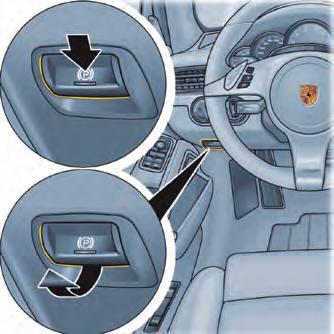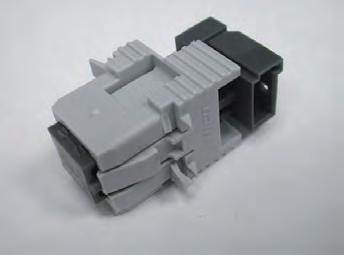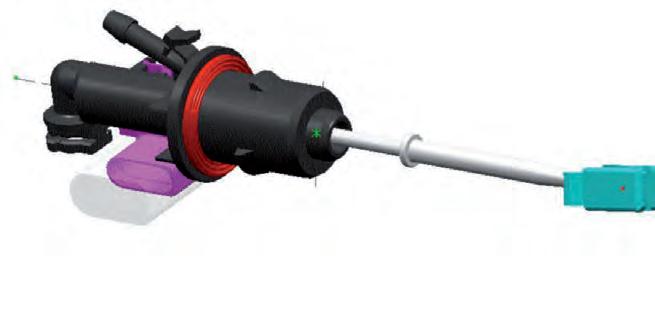
4 minute read
Electric parking brake
Chassis 4

4_46_11
4.11 Electric parking brake
General
All 911 Carrera models feature an electrically operated parking brake (EPB) for the first time, which can be controlled conveniently by way of a button at the left of the steering wheel. The electric parking brake can be activated manually using this switch and deactivated when the footbrake is pressed. It is also released automatically following manual activation when the driver’s intention to drive off is detected via the accelerator pedal. The electric parking brake therefore increases comfort and safety when the vehicle is parked and creates more space in the center console due to the omission of the handbrake lever.
Functions
Activating when the vehicle is stationary
Conditions: • Vehicle speed less than 1.4 mph (2.2 km/h) • At least one valid wheel signal per axle • Press operating control
Emergency operation
If there is not at least one valid wheel signal available on each axle, the electric parking brake can be applied and the vehicle reliably held under the following conditions: • Ignition off • Operating control pressed for longer than 10 seconds
Releasing when the vehicle is stationary
Conditions: • Ignition on • Brake pedal pressed • Pull operating control
Automatic release when driver’s intention to drive off is detected
The electric parking brake is released automatically on the flat (gradient of less than 5°) when the driver’s intention to drive off is detected. On a gradient of more than 5°, release of the parking brake depends on the downgrade force. Conditions: • Engine running • Gear selected (PDK = selector lever in D or R, manual transmission = clutch pressed) • Accelerator pedal pressed • Driver’s seat belt fastened • Driver’s door closed
Emergency braking
In dangerous situations, it is possible to decelerate very sharply and stop the vehicle using the electric parking brake instead of the footbrake. Vehicle deceleration of 0.8 g is achieved in this case. Conditions: • Vehicle speed above 2.2 mph (3.5 km/h) • One valid wheel signal per axle • Press operating control continuously
Special functions
Brake test stand mode
The braking action of the parking brake can be tested at any time on a roller-type test stand. The system automatically switches to test mode as soon as one axle is driven while the other is stationary. The service brakes of the front and rear axle can be tested normally. To test the parking brake, the button must be pressed continuously until the highest braking torque is reached or the vehicle jumps out of the test stand.
Emergency release
The emergency release function should be used only if the brake can no longer be released electrically (actuating element itself is faulty). The oval-head screw on the back must be removed and the brake released using an Allen key for this purpose. Chassis 4

Chassis 4

PSM control unit (CAN)
Speed Longitudinal acceleration Brake light sensor Emergency braking (brake pressure build-up)
PSM unit
Pump motor Inlet valve FL Inlet valve FR Inlet valve RL Inlet valve RR
Operating control button
PDK
Gear selected
Terminal 15, 30, 31
Clutch sensor (manual transmission only) Control unit

The control unit is mounted on the control unit carrier behind the rear seats.
EPB control unit Instrument cluster
Texts, function light
Parking brake switch
Function light
Left actuator
Servo motor Hall-effect sensor
Right actuator
Servo motor Hall-effect sensor
The EPB control unit receives input signals from the PSM control unit: Speed signal (CAN) - wheel speeds are detected in order to run the various functions, depending on vehicle speed.
Longitudinal acceleration (CAN) - the gradient is detected in order to activate/deactivate the Drive-Off Assistant.
Brake light sensor (CAN) - instead of a conventional brake light switch, a Hall-effect sensor (see Fig. 4_47_11) transmits the position of the brake pedal. It consists of two Hall-effect sensors with a permanent magnet mounted in front. If the pedal touches the sensor when released, the position is detected by the
change in the magnetic field. If the system detects that the brake is pressed, the parking brake is released on request.
The EPB control unit supplies information regarding the targeted build-up of brake pressure required for the introduction of emergency braking to the PSM control unit.
Clutch sensor (manual transmission only)
The clutch sensor, which is located on the clutch master cylinder, supplies another input signal in order to detect the position of the master piston. The piston contains a permanent magnet for this purpose. The different positions of the magnet generate particular field strengths, which can be used to determine the sensor position. The sensor supplies up to three different signals, which provide information about the position of the piston such as clutch pedal pressed, piston travel and clutch fully depressed. • The first signal switches off adaptive cruise control. • The next signal is a pulse-width-modulated signal, which indicates the piston travel. This is used in conjunction with the Drive-Off Assistant to slowly reduce the brake pressure as a function of clutch travel. • The third signal, with the clutch pedal fully depressed, is the switching position for the Start Lock function (Interlock). Chassis 4

4_48_11







